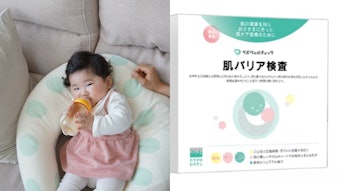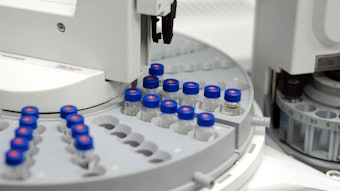The stratum corneum (SC) has been well recognized as a principal water barrier of the skin. It is a cellular tissue, a fabric of cornified cells creating a tough, flexible, coherent membrane, acting as a two-way barrier, minimizing water loss, electrolytes and other body constituents, and decreasing the entry of noxious substances from the external environment.1,2 Maintenance of the SC structural integrity is critical to barrier function. Transepidermal water loss (TEWL) documents the integrity of SC water barrier function, and is a sensitive indicator of skin water barrier alteration.3 Healthy SC typically has a water content of 10–20%;2 the TEWL can be dramatically altered if this barrier function is perturbed by physical, chemical, therapeutic or pathological factors.4-7
Tape stripping is a commonly used method for investigating SC physiology as well as bioavailability and bioequivalence of topical drugs. The number of tape strips needed to remove the SC varies with age, gender and possibly ethnicity, as well as the application pressure.6,8 A previous publication compared an open and a closed chamber device in measuring TEWL on healthy volunteers.9 However, comparable data on stripped skin with higher evaporation rates remained unavailable.
The current preliminary study compared the sensitivity and correlation of open chamber device and closed chamber device on a tape stripping human model. The amount of SC removed by tape stripping was also quantified with a protein assay method.
Materials and Methods
Subjects: Ten healthy volunteers (6 male and 4 female; 7 Caucasians and 3 Asians; mean age 38 ± 16 years) who met the selection criteria were enrolled after providing informed consent. Subjects had no skin disorders and were instructed not to apply topical products to the test sites for one week prior to and during the study. This study protocol and informed consent form were reviewed and approved by the Committee on Human Research at University of California, San Francisco.
Materials: Tape stripping was performed by skin sampling discsa; these discs will be referred to as tape strips in the following discussion.
Instruments: TEWL was assessed by an open chamber deviceb and a closed chamber devicec. The measuring principle and standard guidelines are published.10,11 The values of TEWL were expressed as g/m2 per hr.
Experimental design: This study was randomized; each test area was chosen in a random manner. Each volunteer served as his or her own control between the different test regions.
General procedure: In a random manner, the TEWL on one forearm of each subject was measured with the open chamber device and the TEWL on the opposite forearm was measured with the closed chamber device. After recording baseline measurements, 20 tape strippings were taken on each test site with the skin sampling discs. TEWL was re-measured following 10 and 20 tape strippings at each test site.
Tape stripping: The skin sampling disc was placed on the test sites with forceps, utilizing gloved hands. The disc was pressed onto the skin using a roller. The roller was then removed and the tape disc peeled from the skin with forceps in a unidirectional manner for all sites. Twenty tape strips were taken from each test site. Immediately after each tape stripping, individual tape was placed into a scintillation vial. These strips were analyzed to quantify the amount of removed SC with a modified protein assay.
Protein assay: SC aggregates in the strips were analyzed with a modification of Dreher’s method; details can be found elsewhere.6,12 TEWL measurements were conducted in a room with daily relative humidity (RH) of 43.3 ± 3.1% and temperature of 18.8 ± 1.3°C. These values (RH and °C) were recorded throughout the experimental period. Each subject rested for at least 30 min to acclimate before measurements.
Statistical analysis: Statistical analysis was performed utilizing a computer programd. Differences on two measured sites were analyzed utilizing the t-test. Correlations between devices were analyzed by linear regression. Statistical significance was accepted at p < 0.05.
Results
The mean values of TEWL obtained from the two devices were similar after 10 strips and 20 strips. Data of TEWL are summarized in Table 1. Data were subtracted from baseline values and shown as mean ± standard deviation (S.D.). Coefficient of variation (CV%) was calculated as (S.D./mean) × 100%. There was no statistically significant difference between the sites measured by open versus closed chamber devices after 10 or 20 strips.
Figure 1 illustrates the scatter of TEWL values from the two devices after 10 and 20 strippings.
SC protein amounts in the strips were similar and without a statistically significant difference between two sites, as measured by open versus closed chamber devices.
Discussion
Noninvasive bioengineering techniques such as TEWL measurements have been used extensively in laboratory and clinical settings to assess the mechanical and physiological properties of skin water barrier function in health and disease. Its value becomes apparent in providing accurate, reproducible and objective measurements that can determine subtle differences before visual clinical signs.3,10,11
Ventilated chamber (open chamber) is capable of continuous TEWL measurement. Unventilated chamber (closed chamber) method might be incapable of continuous TEWL measurement and might tend to occlude the skin.10 However, both methods might be interfered with by the microclimate near the surface of the skin, thereby influencing the water loss to varying extents. Extensive descriptions of methods and measuring principles of TEWL and devices can be found elsewhere.10,11,13
The current study compared the sensitivity between an open and a closed chamber device by utilizing the tape stripping method. Both devices yielded TEWL values that were similar on stripped human skin in vivo. This was in accordance with the authors’ previous report on healthy intact skin.9 If the occlusion time of the closed chamber device on the skin is too long, saturation might occur. If this closed chamber device is left on skin for only 10 sec or so, saturation does not occur.
Many factors might influence the stripped SC amounts.6-8 Therefore, the authors also determined the SC protein amounts in the removed strips to ascertain if other factors such as contact area and pressure of two devices on skin might affect the tape stripping amounts. However, there was no statistically significant difference of SC stripped amounts between two sites measured by open versus closed chamber devices.
To perform accurate and reliable measurements, several factors and sources of variation need be taken into account.10,11,14,15 One limitation of the study was that few individuals were observed, so it is possible that TEWL measurements, although high, could be further elevated. Another issue is that no factory calibration was made immediately prior to this preliminary study; hence the inter-instrument and intra-instrument variation might be affected.
These limitations suggest the need for a validation study with more measurements covering the whole range of TEWL before drawing any conclusion on the similarity and differences between the methods. Thus, the authors are not making the general conclusion that the differences in the data here are explained by the differences in the measuring principles of the two devices. Limited results of TEWL values measured by both instruments were consistent with small standard deviations, suggesting that both might be used in stripped human skin in vivo and other clinical situations as well. A recent experiment validated both instruments.16
Summary
This study compares the sensitivity and correlation of an open chamber device and a closed chamber device used in a tape stripping human model. The study suggests that both devices might yield similar TEWL values on stripped human skin in vivo. Reproduction of all or part of this article is strictly prohibited.
To get a copy of this article or others from a searchable database, visit the C&T magazine article archives at CosmeticsandToiletries.com/magazine/pastissues.
References
Send e-mail to [email protected].
1. AM Kligman, Hydration injury to human skin: A view from the horny layer, in Handbook of Occupational Dermatology, L Kanerva, P Elsner, JE Wahlberg and HI Maibach, eds, Berlin: Springer (2000) pp 76–80
2. H Baker, The skin as a barrier, in Textbook of Dermatology, 2nd edn, A Rook, DS Wilkinson and FJG Ebling, eds, Oxford: Blackwell Scientific Publications (1972) pp 249–255
3. KP Wilhelm, C Surber and HI Maibach, Quantification of sodium lauryl sulphate dermatitis in man: comparison of four techniques: skin color reflectance, transepidermal water loss, laser Doppler flow measurement and visual scores, Arch Dermatol Res 281 293–295 (1989)
4. L Yang, M Mao-Qiang, M Taljebini, PM Elias and KR Feingold, Topical stratum corneum lipids accelerate barrier repair after tape stripping, solvent treatment and some but not all types of detergent treatment, Br J Dermatol 133 679–685 (1995)
5. PG van der Valk and HI Maibach, A functional study of the skin barrier to evaporative water loss by means of repeated cellophane-tape stripping, Clin Exp Dermatol 15 180–182 (1990)
6. SJ Bashir, AL Chew, A Anigbogu, F Dreher and HI Maibach, Physical and physiological effects of stratum corneum tape stripping, Skin Res Technol 7 40–48 (2001)
7. MJ Choi, H Zhai and HI Maibach, Tape stripping method and stratum corneum, in Dermatotoxicology, 6th edn, H Zhai and HI Maibach, eds, Boca Raton: CRC Press (2004) pp 531–548
8. H Loffler, F Dreher and HI Maibach, Stratum corneum adhesive tape stripping: Influence of anatomical site, application pressure, duration and removal, Br J Dermatol 151 746–752 (2004)
9. JH Shah, H Zhai and HI Mailbach, Comparative evaporimetry in man, Skin Res Technol 11 205–208 (2005)
10. J Pinnagoda, RA Tupker, T Agner and J Serup, Guidelines for transepidermal water loss (TEWL) measurement, Contact Derm 22 164–178 (1990) 11. P Elsner, E Berardesca and HI Maibach, eds, Bioengineering of the Skin: Water and the Stratum Corneum, Boca Raton: CRC Press (1994) 1
2. F Dreher, A Arens, JJ Hostynek, S Mudumba, J Ademola and HI Maibach, Colorimetric method for quantifying human stratum corneum removed by adhesive-tape stripping, Acta Derm Venereol 78 186–189 (1998)
13. J Fluhr, P Elsner, E Berardesca HI Maibach, eds, Bioengineering of the Skin: Water and the Stratum Corneum, 2nd ed, Boca Raton: CRC Press (2005)
14. J Nuutinen, A closed unventilated chamber for the measurement of water loss, Skin Res Technol 9 85–89 (2003)
15. J Nuutinen, I Harvima, M-R Lahtinen and T Lahtinen, Water loss through the lip, nail, eyelid skin, scalp skin and axillary skin measured with a closed chamber evaporation principle, Br J Dermatol 148 839–841 (2003)
16. K De Paepe, E Houben, R Adam, F Wiesemann and V Rogiers, Validation of the VapoMeter, a closed unventilated chamber system to assess transepidermal water loss vs. the open chamber Tewameter, Skin Res Technol 11 61–69 (2005)










